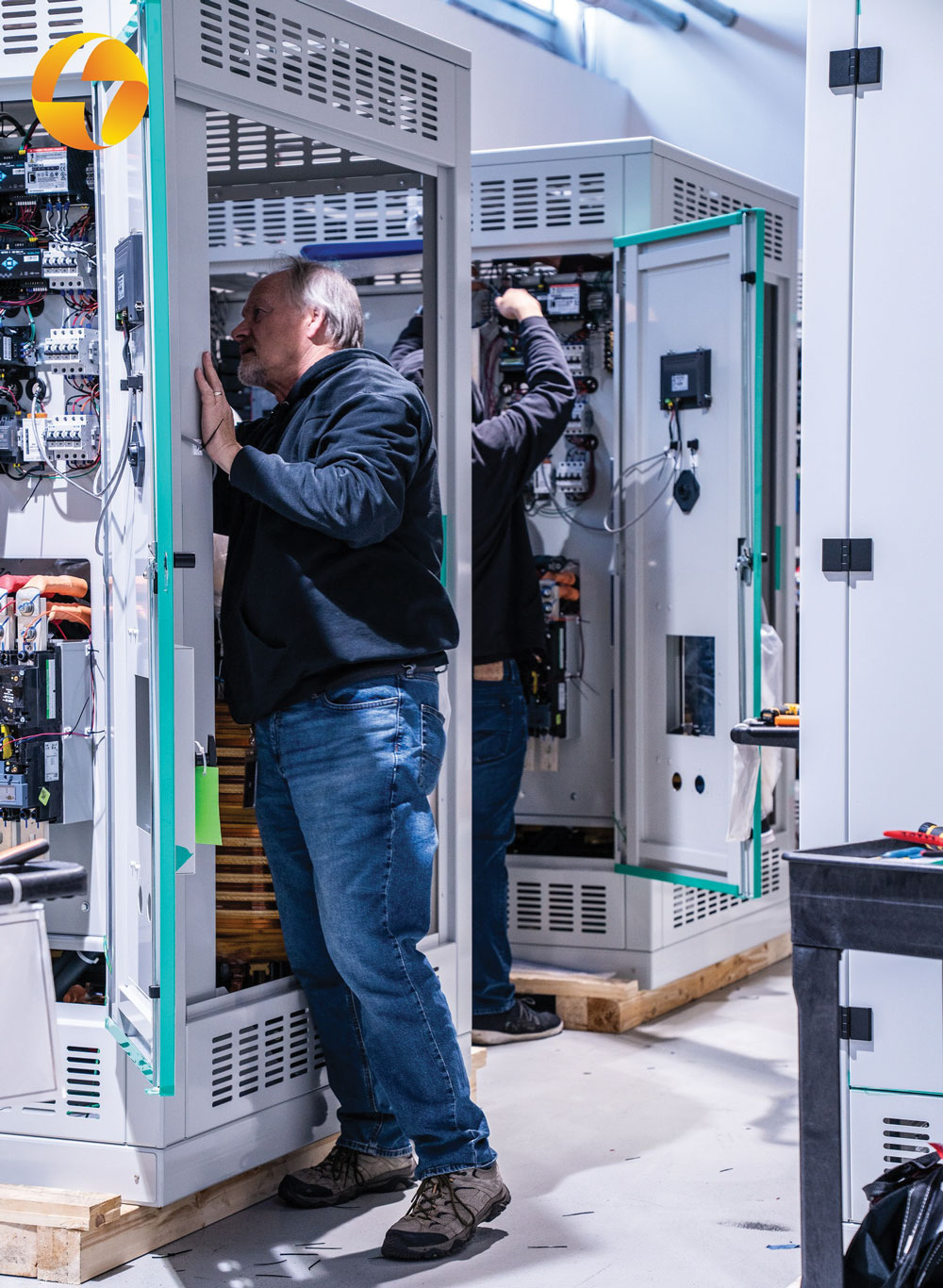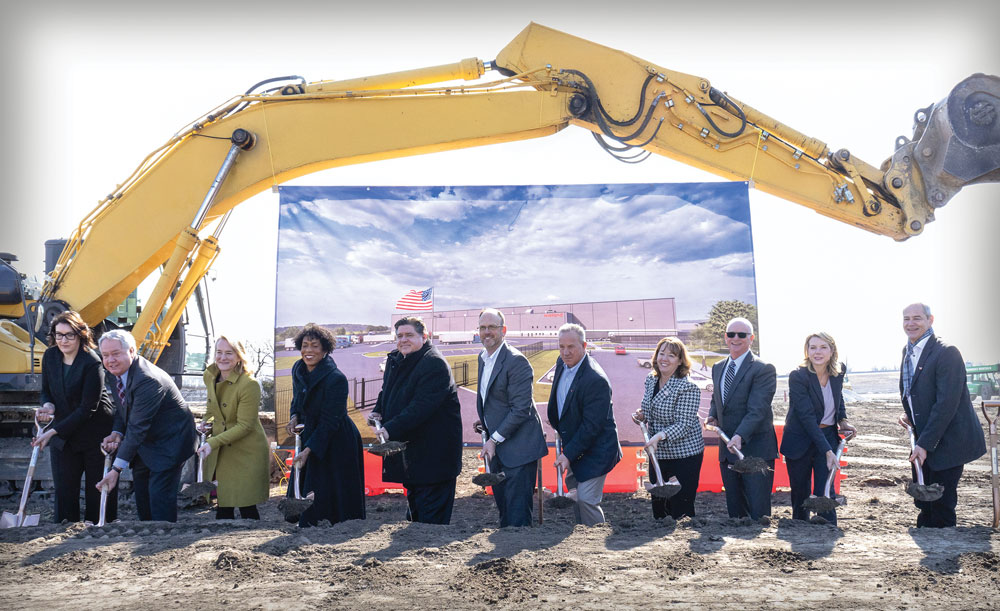There’s a variety of ways to make it in Illinois — and the state’s extensive roster of over 13,000 manufacturers take that notion seriously.
These operations support more than 588,000 jobs across the state, a resilient manufacturing workforce base that ranks fifth nationally and third in the Midwest. In securing the No. 2 state for new and expanding companies for the third year in a row, Illinois knows how to reinforce its production powerhouse status.
When New-Jersey based Raptor Power Systems Founder Evan El Koury was looking to expand the company’s manufacturing footprint outside of the state for the first time, he found everything his businesses needed to scale in Champaign County.
Raptor currently runs two manufacturing facilities in New Jersey, producing mission-critical power distribution units (PDUs) and uninterruptible power supplies (UPS) used for military, industrial, data center and crypto mining applications. El Koury learned the ropes from his father Peter, who started Powerspec Inc. in the early 1990s as a UPS systems contract manufacturer for the military. About 14 years ago, El Koury saw the opportunity to diversify the small company’s product portfolio, shifting focus to data centers and establishing Raptor Power Systems as a subsidiary of Powerspec.
The flexibility of operating as a small business allowed El Koury’s team to develop a product that solved supply chain issues faced by larger original equipment manufacturers like Siemens, ABB and Schneider. The company later landed large contracts that launched Raptor’s product into the existing U.S. supply chain, marking the shift from operations within a small-scale garage shop to soon welcoming its largest manufacturing location to date.
During an extensive site selection search, the East Central Illinois region stood out for its low cost of living, access to University of Illinois Urbana-Champaign talent and programming, transportation infrastructure, a large regional manufacturing workforce and community support.
“It was one of the best mixes,” El Koury says. “When we were hunting spaces a lot of the times I found that where you might find a little cheaper land or might find cheaper labor, what you’re not finding is a good mix of professional and blue collar in the same community with a low cost of living.”
“It was one of the best mixes. When we were hunting spaces a lot of the times I found that where you might find a little cheaper land or might find cheaper labor, what you’re not finding is a good mix of professional and blue collar in the same community with a low cost of living.”
— Evan El Koury, Founder, Raptor Power Systems
Between two sites in the region, Raptor purchased a 65,000-sq.-ft. building from real estate developer Atkins Group on a site that would allow for an expansion up to 300,000 additional sq. ft.
“We’re starting a little bit smaller,” says El Koury. “In a short order, I can add this extra space as required and turn this area into a campus that we can call our forever home.”
Skilled talent was a critical factor, as Raptor’s manufacturing process has yet to turn fully automated. The company instead trains its employees to be artisans in assembling remote power panels (RPP) and floor power PDUs. RPPs between 400 to 600 amps typically take about four hours to assemble, while PDUs between 500 and 1,000 kVA take up to 30 hours per unit to build. Currently, the company’s New Jersey facilities produce about 400 RPPs and 100 PDUs a month. Once operational, the north Champaign plant will contribute an additional 1,100 RPPs and 600 PDUs per month.
To ensure a pipeline of skilled local talent, Raptor is working to finalize plans with local economic developers to develop a community college program to train and certify workers to construct these power systems. In the prime era of data center development, with industry leaders such as Microsoft, Meta and Oracle planning projects up to a decade out, Raptor is positioning itself to meet new opportunities to adapt to evolving industry needs.
As the new facility gears up to meet its first contractual obligation in August, El Koury says activity is bustling at the facility as materials and 75 new employees file in.
“This investment marks a significant advancement in our manufacturing capabilities in Illinois and across the United States by enhancing our efficiency, precision, and potential output capacity. It also ensures that we remain adaptable in a constantly evolving market. We are well-positioned to increase and improve our production of essential copper and copper alloy components, which are vital for establishing a robust supply chain across various industries and end markets.”
— Greg Keown, President, Wieland Rolling & Recycling
“To see it really coming together has been special for me,” El Koury says. “Especially starting in a 10-by-10 office here to now having this entire factory and being president of the entire company has been a heck of a journey.”
Resources Designed to Scale
Approval of the state’s $55.1 billion FY26 budget from the Illinois General Assembly in June provided space to introduce a new manufacturing tax credit program, while leaving room to make improvements to key tax initiatives including the Reimagining Energy and Vehicles in Illinois (REV Illinois) program and the Economic Development for a Growing Economy (EDGE) tax credit.
The fresh Advancing Innovating Manufacturing for Illinois (AIM Illinois) tax credit is designed for manufacturers delivering significant capital investment in the state. It takes a keen focus to small and medium-sized companies looking to make large investments toward equipment or facility needs. The three-tiered AIM credit covers a maximum of 3% of capital expenditures for investments between $10 million to $50 million made in Illinois, increasing to coverage of up to 7% on investments of $100 million or more. It’s a move that leadership hopes will help land and retain growing businesses.
Combined with programs such as REV Illinois and EDGE, manufacturers spanning any number of industries can find an incentive program that fits their business needs. Industry feedback led the state to increase incentives provided to companies investing over $100 million on a project, while REV Illinois extends its program eligibility to now cover additional EV supply chain industries.
The introduction of AIM Illinois builds upon the new project investment successes bolstered by the REV Illinois and EDGE programs. This traction continues to fuel expansions seen statewide, although evolving alongside the needs of its small to mid-size manufacturers was a chief growth opportunity pinpointed by Illinois leadership.
Why It Works
REV Illinois was a sweet incentive package addition Wieland Rolled Products North America wasn’t looking to pass up when it announced plans to invest $500 million in the modernization of its East Alton site.
In March 2025, Wieland broke ground on the project designed to help increase production capacity of components required for EV, EV charging infrastructure and renewable energy production. The East Alton facility will be fitted with a preheat furnace, hot mill, milling line, cold mill and intralogistics systems. This investment further demonstrates the company’s long-term commitment of operation in Illinois, which includes their five other facilities in Carol Stream, Granite City, Montgomery, Tinley Park and Wheeling. The company is eligible for up to $150 million in REV Illinois and other state incentives over the next 30 years.
“This investment marks a significant advancement in our manufacturing capabilities in Illinois and across the United States by enhancing our efficiency, precision, and potential output capacity. It also ensures that we remain adaptable in a constantly evolving market,” says Wieland Rolling & Recycling President Greg Keown. “We are well-positioned to increase and improve our production of essential copper and copper alloy components, which are vital for establishing a robust supply chain across various industries and end markets.”
Keown say the East Alton facility, which has been in operation for over 100 years, embodies the hard work, dedication and passion required to meet North American market needs. The tremendous investment support Wieland received from Illinois state leadership and local institutions in the form of incentives was a reminder of why the company chose to avoid new site exploration and reinvest in the community.
“These upgrades will transform the plant into a world-class production facility equipped with modern technology, a high level of automation and lean processes,” he notes. “This will ensure superior product quality and provide best-in-class service to our Wieland customers.”

Raptor Power Systems is opening its largest manufacturing site
in Champaign.
Photo courtesy of Raptor Power Systems
In Chicago, Freedman Seating Company chose to take advantage of EDGE when pursuing new facility equipment upgrades and site improvements. The $4 million project follows the recent expansion of the 71-year-old facility, which now spans 650,000 sq. ft. in the city’s Austin neighborhood.
New equipment will enhance operational efficiency and grow the company’s manufacturing capabilities, as the plant currently produces 2,000 seats per day across bus, rail, maritime and truck markets. The investment will create an additional 50 jobs in the region once complete.
“Programs like EDGE don’t give businesses a handout — they help level the playing field. They allow companies like ours to invest, grow and compete while creating more opportunities where they are needed most,” said Freedman Seating Company CEO Craig Freedman. “Without real, tangible support, businesses will leave. When that happens, communities suffer. We continue to invest in our facilities and our people because we believe in the West Side, we believe in Chicago, and we believe in Illinois.”

